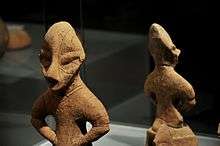Goddess on the Throne
Goddess on the Throne (Albanian: Hyjnesha në fron, Serbian: Богиња на трону / Boginja na tronu) is a terracotta figurine found at the site of the Tjerrtorja spinning mill near Pristina, Kosovo,[lower-alpha 1] in 1956. The archaeological work of the National Museum of Serbia was led by the curator Radoslav Galović. The genderless seated terracotta figure is a well-preserved specimen of small Neolithic plastic Vinča culture (also known as Turda culture or Turda-Vinča culture in Kosovo). It measures 18.5 cm high and is dated to 5700–4500 BC.[1]
The figurine represents a female deity, reflecting the cult of the great mother idol. It is preserved in the Museum of Kosovo. The Kosovo Museum has adopted the image of the 'Goddess on the Throne' as the institution’s distinctive logo. One of the most precious archaeological artifacts of Kosovo, it has been adopted as the symbol of Pristina.[2]
Gallery
Notes
- Kosovo is the subject of a territorial dispute between the Republic of Serbia and Republic of Kosovo.
References
- Goldsworthy, Adrian Keith; Haynes, Ian; Adams, Colin E. P. (1997). The Roman army as a community. Journal of Roman Archaeology. p. 100. ISBN 1887829342. Retrieved 2 March 2014.
- Berisha, Milot (2012) Archaeological Guide of Kosovo.- Ministry of Culture, Youth and Sport, Archaeological Institute of Kosovo, Prishtina, p.42 Last accessed 27 May 2016

